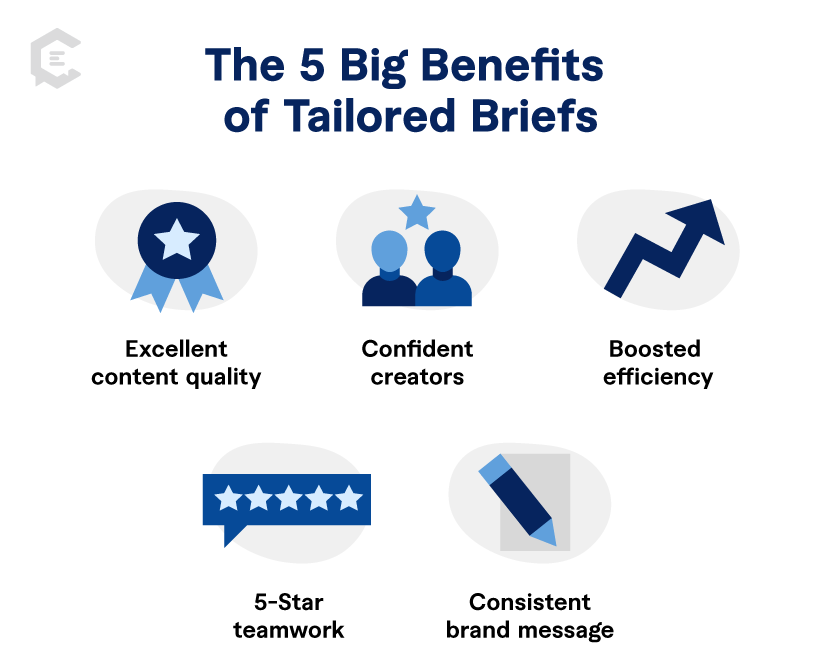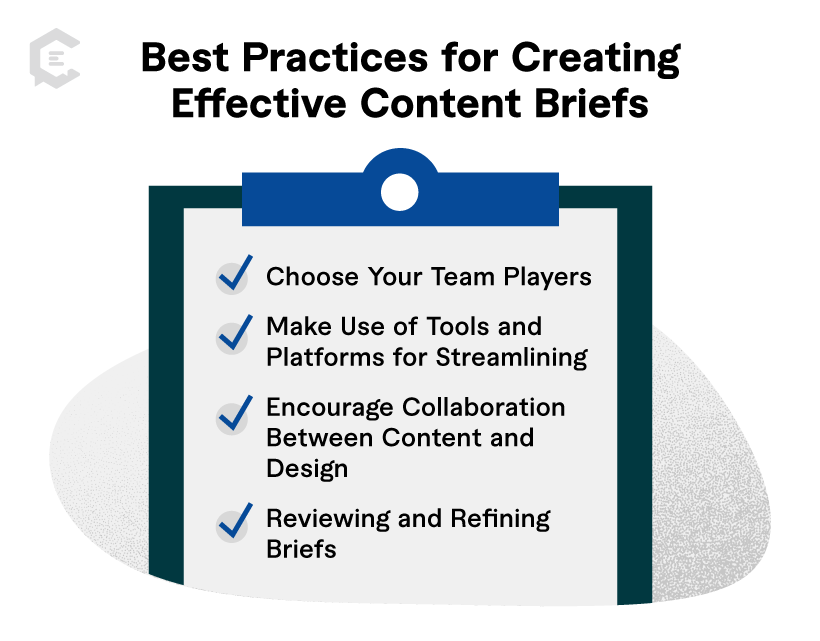Ever dreamt up a brilliant content plan, only to see it poorly executed because you weren’t sure how to brief the creator specifically? Or worse, have you poured your heart into a detailed brief only to get back content that’s way off the mark? We’ve all been there, breathing deep sighs and thinking, “I swear I explained it perfectly!”
Content briefs are an essential foundation for successful content plans. Briefs guide creators, align teams, and ensure the final product meets creative and strategic goals. With some expert tips and customization tricks, you can draft briefs that are more than basic. They’ll have your writers, designers, or whoever’s creating your content visualize and execute the dream you described.
This article delves into the art of crafting content briefs for various formats, exploring how to customize your approach for blogs, videos, white papers, infographics, and more. We’ll also touch on the role of design in the briefing process and how it fits into the bigger picture of content creation.

The Importance of Customizing Content Briefs
Different content formats have unique requirements, ways of engaging the audience, and production needs. What works for a blog post might confuse a video producer. Tailored briefs provide more information in the creator’s language.
One-Size-Fits-All Briefs Don’t Work
Generic copy-paste briefs can end up causing endless back-and-forth emails as everyone tries to get on the same page. Here’s the scoop on why one-size-fits-all briefs often create more confusion than clarity:
- Misaligned expectations: Different formats require different inputs. A brief that doesn’t account for these differences can lead to misunderstandings and wasted effort.
- Overlooked format-specific details: Each content type has unique considerations. A one-size-fits-all approach might miss crucial elements, like visual direction for videos, tone for content writing, or illustrated needs for infographics.
- Inefficient resource allocation: Generic briefs can result in teams wasting time figuring out format-specific needs rather than focusing on creating great content.
To meet a deadline, ensure your brief is clear and optimized for that specific task! Familiarizing yourself with the nitty-gritty of the design or writing needs will help you explain what you’re looking for in a final product. In other words: use lingo specific to the task for the best results!
The 5 Big Benefits of Tailored Briefs
When you become skilled in customized briefing, you’ll get to celebrate these many perks:
- Excellent content quality: When creators have clear, format-specific guidance, they can focus on producing stellar content that nails those brief requirements.
- Confident creators: Good briefs instill confidence in the team. Every creator will motor forward, knowing they’re on the right track and heading in the same direction. A poor or vague brief will have them feeling a little lost and directionless. Nothing drains confidence like uncertainty.
- Boosted efficiency: Tailored assignment briefs streamline the creation process by providing all essential information from the get-go, reducing tedious back-and-forth communications (and eye-rolls!).
- 5-Star teamwork: Custom briefs boost teamwork between content creators, designers, and other team members by clearly stating each person’s job and expectations.
- Consistent brand messaging: Format-specific briefs ensure that your brand voice and key messages are developed properly for each content type. Looking for consistency across all channels? You’ve got it!
- You’ll stand out: Well-crafted content will excite customers about your product, increase traffic and interest, and improve your business’s bottom line.
Crafting the Perfect Brief for Every Content Type
Keen to up your game in brief creation? Here are must-haves you may not have considered for various content briefs:
Blog Posts
You’ve mastered those basics, but surprise your writer with the following additions in your next blog post brief:
- Target audience and their pain points, along with your solution
- Desired tone, grammar rules, and writing style
- SEO needs from keywords to title tags and meta descriptions
- Readability level or content level
- Desired structure (e.g., listicle, how-to guide, opinion piece)
- Call-to-action (CTA) requirements
Best practices for briefing writers on SEO and editorial guidelines:
- Provide straightforward keyword usage and placement guidelines (e.g., Where do you want the primary keyword mentioned?)
- Outline internal and external linking expectations
- Include any brand-specific style guide elements
Video Content
Video briefs differ significantly from written content briefs. Key elements to include:
- Video goal
- Script outline or talking points
- Visual direction and style guidelines
- Audience engagement goals (e.g., educate, entertain, persuade)
- Required graphics or animations
- Music and sound effect preferences
Don’t forget to include storyboarding and production details:
- Shot list or scene breakdown
- Location requirements (if any)
- Talent needs (actors, voiceover artists)
- Post-production effects or editing style
White Papers and Long-Form Content
For in-depth content like white papers, consider these specific briefing needs:
- Detailed content outline with heading and subheading ideas
- Research requirements and preferred sources
- Citation and referencing style
- Brand guidelines
- Target audience and the purpose of the content
Tips for guiding tone, structure, and expertise level:
- Specify the level of technical language appropriate for the target audience
- Outline the desired balance between text, graphics, and white space
- Provide examples of successful white papers in your industry
Infographics and Visual Content
When briefing for infographics, include:
- Key data points to be visualized
- Preferred chart types or visualization methods
- Color palette and visual style guidelines
- Text-to-image ratio expectations / Text hierarchy
- Desired file formats and sizes
To ensure visual content aligns with overall messaging:
- Provide context on how the infographic fits into larger marketing campaigns
- Specify any branding elements that the creator must include
- Outline the key takeaway or story the infographic should tell
Your Content Briefs Need Designs!
People love visuals. A great design improves readability, reinforces branding, and improves user engagement. If you want a cohesive marketing campaign outcome, here is why you must consider design elements from the start of your content strategy session:
- Over 50% of marketers say visuals are essential to their campaigns.
- Consumers have also had their say, with over 91 percent wanting to see more online videos from brands
- Short-form videos have the highest return on investment (ROI) of all marketing forms
- Illustrations and infographics help readers follow directions and information 323 percent more than text-only formats
Items to Include in the Design Portion of a Content Brief
Take the time to cement the core elements of your brand aesthetic. When it comes time to brief designers and video editors, you can present them with brand guidelines that include details like:
- Logos, color palettes, typography
- Usage examples
- Brand voice guidelines
- Examples of designs that you like for inspiration
- Rules around icons and images (style of stock imagery)
- Visual style preferences — bold, illustrative, maximalist, minimalist
- Specifics for marketing tools like email campaigns, social media content, packaging, and more
Best Practices for Creating Effective Content Briefs
1. Choose Your Team Players
Having a content leader or Content Management Partner can ease stress regarding guiding, briefing, and signing off on content formats. From there, select the key players in your content creation and establish clear roles and responsibilities for each team member.
2. Make Use of Tools and Platforms for Streamlining the Briefing Process
If you’re aiming to streamline your content game, then there are some super project management tools to help you get there. Asana, Airtable, or Trello help keep your projects on track with customizable progress reports. Their various workflow solutions will make your workflow smoother and your team happier as they save time and help with organization. And hey, don’t forget about AI — with the right inputs, it can craft briefs faster than you can say “content creation”!
3. Encourage Collaboration Between Content and Design Teams
Host your content strategy session with all key players present to involve both content and design teams in the briefing process from the start. Throughout the project, using some of the tools and platforms mentioned above allows for real-time feedback and ideation.
4. Reviewing and Refining Assignment Briefs
Regularly review and refine your briefs to ensure they meet evolving content and design needs:
- Conduct post-project reviews with creators as well as final decision-makers to identify areas for improvement
- Recognize any areas of misalignment and implement feedback
- Create template libraries for different content types to streamline future projects
- Use project management tools to simplify the briefing process
Maximize Impact with Well-Structured Briefs
Tailored content briefs are the secret map to keeping things running smoothly, no matter what type of content you create. When you nail this step with your team, each piece of content gets the clear direction it needs to shine. A good brief is an investment in your content’s success — it sparks creativity and confidence, keeps your brand consistent, and delivers results across every format.
Optimize your content briefing process and connect with a Clearvoice content strategist today. We’ll help you create briefs and content that suit your diverse marketing needs.










